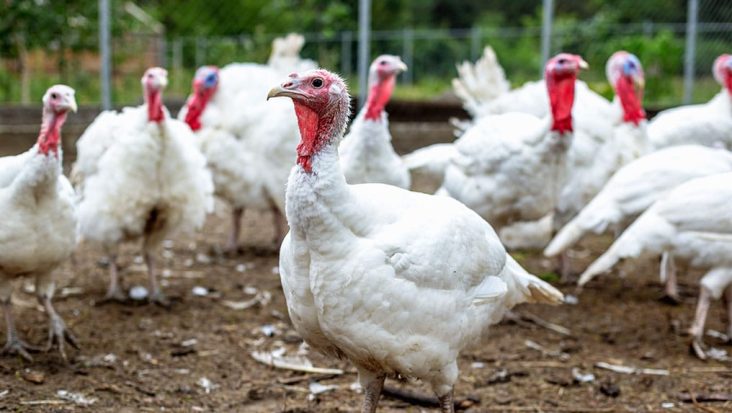Arkansas turkey production numbers better than U.S. average
by November 14, 2023 7:20 am 747 views

Avian influenza had a significant impact on U.S. turkey production in 2022 and it led to higher prices for Thanksgiving meals. Production is up nationwide, and in Arkansas, turkey production is higher than the national average.
Arkansas is third in national rankings of turkey production, according to the latest U.S. Department of Agriculture’s (USDA) Turkeys Raised report. Arkansas turkey production is up 6% to 27.5 million turkeys. The largest turkey-producing state is Minnesota with 39 million turkeys, up 5% from the previous year. North Carolina has produced 29 million turkeys this year, up 4% from a year ago.
Enough turkey has been produced with the rebound from bird flu last year that exports have increased in 2023 and are projected to continue that trend in 2024 based on lower prices for U.S.-grown turkey, notes the latest World Agricultural Supply and Demand Estimates. The net impact to consumers should be lower turkey prices this fall and winter.
“The supplies are looking good, and prices are looking a lot better for the consumer than last year,” said Jada Thompson, assistant professor of agricultural economics and agribusiness with the Arkansas Agricultural Experiment Station, the research arm of the University of Arkansas System Division of Agriculture. “We had highly pathogenic avian influenza last year. That took away a lot of our supplies and drove up the price, so consumers were pinched a little at the store along with some inflationary effects.”
The average price per pound for an 8- to-16-pound whole frozen turkey is now about $1.15 per pound, according to a USDA report. This price is about 35% lower than the same time last year. To help the turkey industry make projections for processing, Thompson is taking into consideration the potential for a change in turkey consumption preferences.
“I think there are some slight changes that are happening to our Thanksgiving plates, and that might shift from a whole turkey to a turkey breast,” Thompson said. “There is a slight demand change for processed turkeys versus just a whole turkey, but I think that turkey is still the center point of a Thanksgiving meal right now.”
The USDA’s annual Turkeys Raised report estimates 219 million turkeys were raised in 2023, a 4% increase over 2022 and 1% more than the levels that preceded the outbreak of highly pathogenic avian influenza, or HPAI. HPAI has reemerged this fall. The USDA Animal and Plant Health Inspection Service (APHIS) reports about 880,000 recent losses to HPAI on turkey farms in Minnesota, South Dakota and Utah. However, the supply for Thanksgiving has already been harvested, Thompson said. Typical placements for Thanksgiving start in July.
“We are keeping an eye on the current outbreaks of HPAI in turkeys,” Thompson said. “While it is concerning to think about the birds lost, in perspective, more than 46 million turkeys will be eaten on Thanksgiving. We had strong placement numbers, cold storage, eggs in incubators, and production efficiencies coming into the holiday that will help ease the burden of the recent cases.”
Turkeys take about 28 days to incubate, and once hatched they take at least 14 weeks to grow for harvest; 18 weeks for larger birds. This is compared to four to eight weeks’ growing time for broiler chickens. Improved biosecurity and ongoing modernization of poultry houses are contributing factors in the bird flu fight, Thompson noted. Modernization of the houses includes changes in the walls and technology for better ventilation, temperature and humidity regulation and pest control, and litter management.
“The turkey industry has done a lot over the past couple of years to account for HPAI, biosecurity being a predominant one,” Thompson said. “I think there is a lot of modernization, a lot of investments going into turkey farms here and all over the U.S.”
Since 2022, a deadly strain of avian influenza called H5N1 has affected more than 59 million birds in 47 states. The only confirmed HPAI outbreak in Arkansas was last year at a commercial broiler chicken facility.
Ongoing research by poultry scientists to understand the H5N1 strain of highly pathogenic avian influenza has allowed producers to “get ahead of it a little — as much as you can to a disease you can’t control,” Thompson said.
In addition to biosecurity measures, there have also been improvements in surveillance monitoring from the farm level all the way up to state, regional and federal levels, she said.
According to the Poultry Site, Israel is the largest per capita consumer of turkey at 22 pounds, compared to 17 pounds in the United States. Mexico accounted for more than half of U.S. turkey exports. While turkey is consumed throughout the year, Thanksgiving and Christmas are peak times.
Thompson, a northwest Arkansas native, is among a small group of agricultural economists who specialize in poultry. She earned bachelor’s degrees in poultry science and agricultural economics, followed by a master’s degree in agricultural economics at the University of Arkansas. She earned a doctorate in agricultural economics in 2016 at Colorado State University, before working as an assistant professor for five years at the University of Tennessee.
Arkansas is home to numerous poultry companies and businesses that support poultry companies and poultry farmers. Most Arkansas chicken and poultry farmers grow birds on contract for poultry companies such as Tyson Foods or Peco Foods, according to the Arkansas Farm Bureau. Butterball is a turkey processing operator with plants and farmers in the state.
The Natural State ranks second in broiler production with 7.42 billion pounds produced with a value of $3.6 billion, according to the USDA. The broiler industry generated $28.3 billion in the U.S. during 2019.
